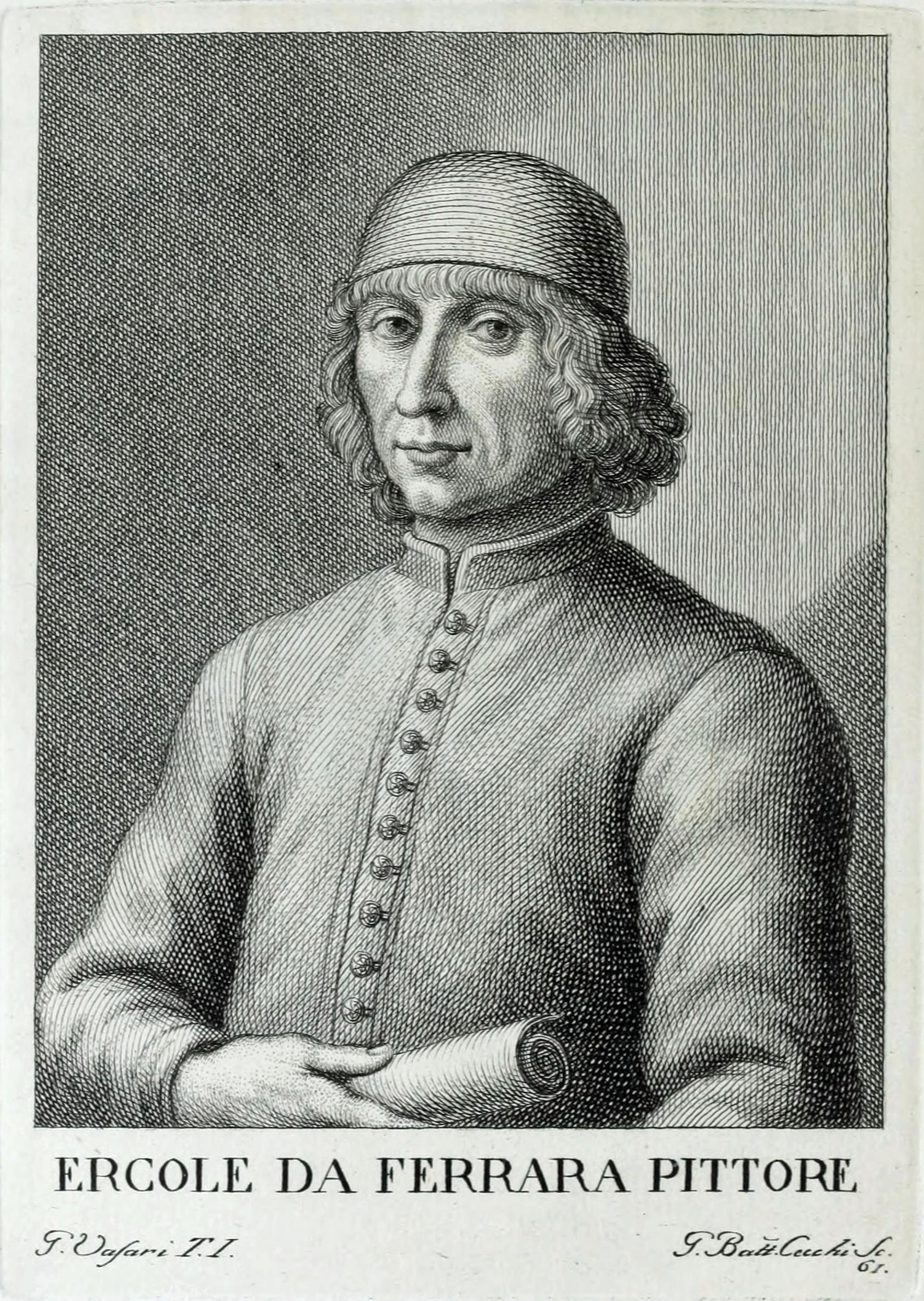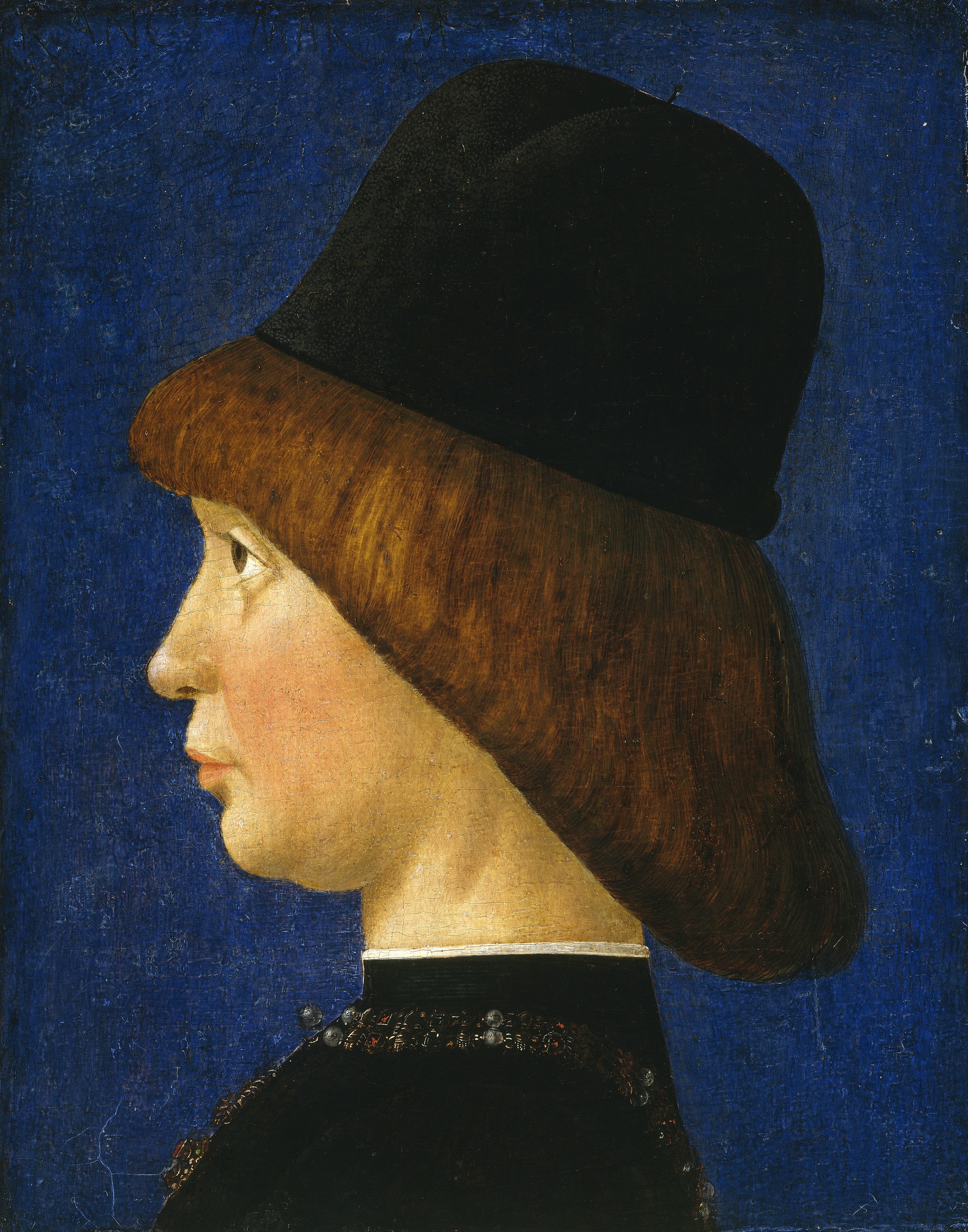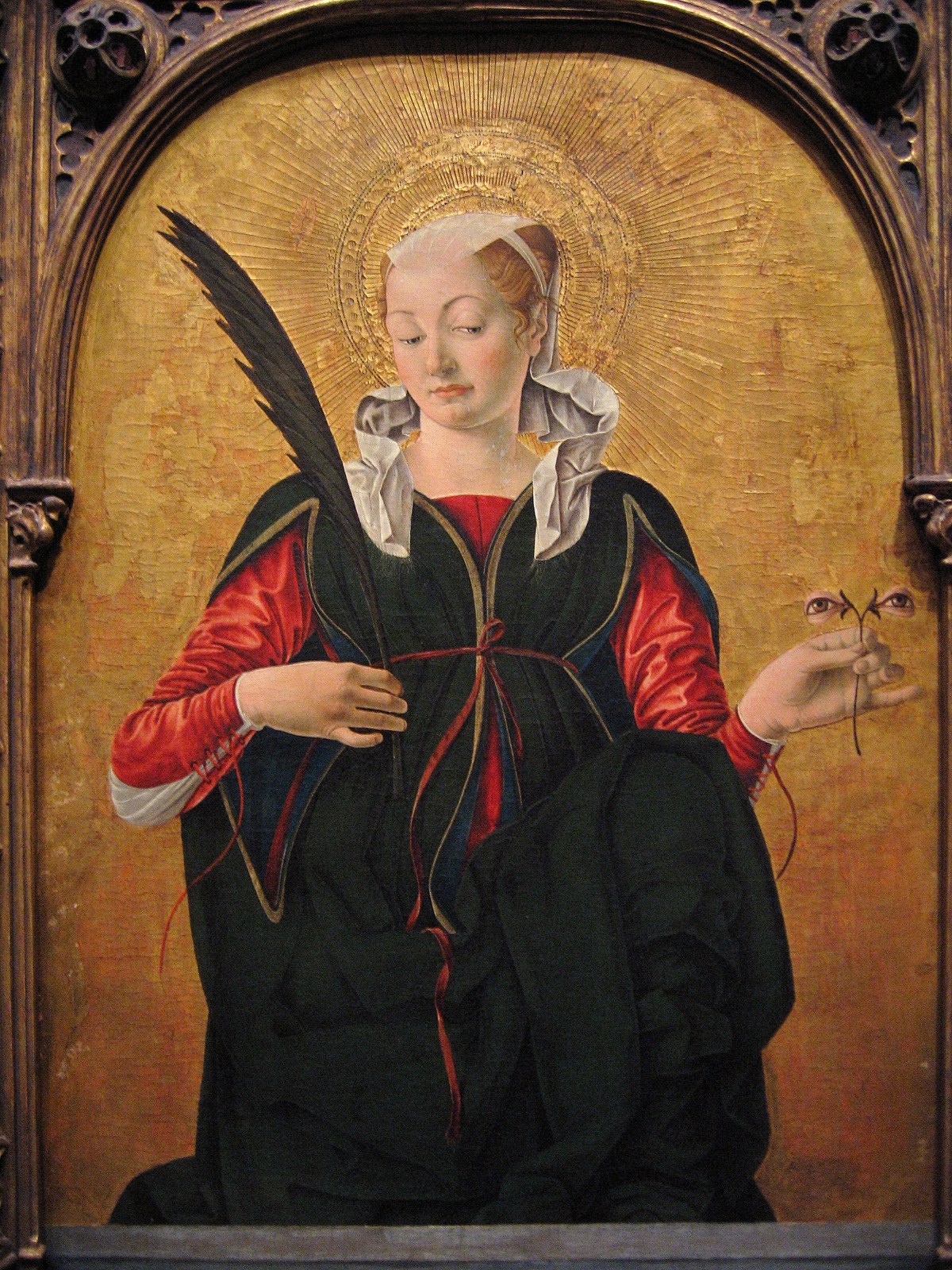|
Ferrarese School (paintings)
The School of Ferrara was a group of painters which flourished in the Duchy of Ferrara during the Renaissance. Ferrara was ruled by the Este family, well known for its patronage of the arts. Patronage was extended with the ascent of Ercole d'Este I in 1470, and the family continued in power till Alfonso II, Ercole's great-grandson, died without an heir in 1597. The duchy was then occupied in succession by Papal and Austrian forces. The school evolved styles of painting that appeared to blend influences from Mantua, Venice, Lombardy, Bologna, and Florence. The ties to Bolognese School were particularly strong. Much of the local collections, like those of the Gonzaga family in Mantua, were dispersed with the end of the Este line in 1598. Especially in the late 15th century Ferrara was also a main centre of engraving in Italy. The most famous prints it produced are the two sets traditionally, if inaccurately, known as the Mantegna Tarocchi, each by an unidentified master. A list ... [...More Info...] [...Related Items...] OR: [Wikipedia] [Google] [Baidu] |
Painters
Painting is the practice of applying paint, pigment, color or other medium to a solid surface (called the "matrix" or "support"). The medium is commonly applied to the base with a brush, but other implements, such as knives, sponges, and airbrushes, can be used. In art, the term ''painting ''describes both the act and the result of the action (the final work is called "a painting"). The support for paintings includes such surfaces as walls, paper, canvas, wood, glass, lacquer, pottery, leaf, copper and concrete, and the painting may incorporate multiple other materials, including sand, clay, paper, plaster, gold leaf, and even whole objects. Painting is an important form in the visual arts, bringing in elements such as drawing, Composition (visual arts), composition, gesture (as in gestural painting), narrative, narration (as in narrative art), and abstraction (as in abstract art). Paintings can be naturalistic and representational (as in still life and landscape art, lands ... [...More Info...] [...Related Items...] OR: [Wikipedia] [Google] [Baidu] |
Cristoforo Da Bologna
Cristoforo da Bologna was an Italian painter. He was active in Bologna, Modena, and Ferrara Ferrara (, ; egl, Fràra ) is a city and ''comune'' in Emilia-Romagna, northern Italy, capital of the Province of Ferrara. it had 132,009 inhabitants. It is situated northeast of Bologna, on the Po di Volano, a branch channel of the main stream .... He painted toward the close of the 14th and the beginning of the 15th century. Sources * 14th-century Italian painters Italian male painters 15th-century Italian painters Trecento painters Painters from Bologna Painters from Ferrara Gothic painters 14th-century births 15th-century deaths {{Italy-painter-14thC-stub ... [...More Info...] [...Related Items...] OR: [Wikipedia] [Google] [Baidu] |
Lorenzo Costa
Lorenzo Costa (1460 – 5 March 1535) was an Italian painter of the Renaissance. Biography He was born at Ferrara, but moved to Bologna by his early twenties, and was probably influenced by the Bolognese School. However, many artists worked in both cities, and thus some consider him a product of the School of Ferrara. It is possible that he trained with Cosimo Tura. In 1483 he painted the famous ''Bentivoglio Altarpiece'' and other frescoes on the walls of the Bentivoglio chapel in San Giacomo Maggiore. He was a great friend of Francesco Francia, who was much influenced by him. In 1509 he moved to Mantua to become the court painter of Marquis Francesco Gonzaga and Isabella d'Este. For the latter's studiolo in the Ducal Palace, he painted the ''Allegory of Isabella d'Este's Coronation'' (now at the Louvre) and the '' Reign of Comus'', two mythological paintings based on Mantegna's drawings. He died at Mantua in 1535. His sons Ippolito and Girolamo were also painters, a ... [...More Info...] [...Related Items...] OR: [Wikipedia] [Google] [Baidu] |
Ercole De' Roberti
Ercole de' Roberti (c. 1451 – 1496), also known as Ercole Ferrarese or Ercole da Ferrara, was an Italian artist of the Early Renaissance and the School of Ferrara. He was profiled in Vasari's ''Le Vite delle più eccellenti pittori, scultori, ed architettori''. __NOTOC__ The son of the doorkeeper at the Este castle, Ercole later held the position of court artist for the Este family in Ferrara. According to Vasari: Paintings by Ercole are rare. His life was short and many of his works have been destroyed. Works By 1473, Ercole had left Ferrara and was working in Bologna in the studio of Francesco del Cossa. According to Vasari, Ercole also apprenticed under Lorenzo Costa in Bologna, but this seems unlikely as he was Lorenzo's senior by several years. Vasari was likely confusing him with Ercole da Bologna or Ercole Banci. Ercole's first mature works are his contributions to the Griffoni Chapel for the San Petronio Basilica in Bologna: a predella depicting the '' Mira ... [...More Info...] [...Related Items...] OR: [Wikipedia] [Google] [Baidu] |
Michele Cortellini
Michele Coltellini (1480–1542) was an Italian painter, active mainly in Ferrara. Biography He was a follower of Panetti and Garofalo, who lived in the 16th century. He is the author of a 'Dead Christ on the lap of the Virgin' in the Dresden Gallery, formerly assigned to Squarcione. His oldest panel is dated 1502, and represents the ''Death of the Virgin'': it is now in the possession of Count Mazza, at Ferrara. In the church of Sant'Andrea Sant'Andrea is the Italian language, Italian name for List of saints named Andrew, St. Andrew, most commonly Andrew the Apostle. It may refer to: Communes in Italy *Castronuovo di Sant'Andrea, Basilicata *Cazzano Sant'Andrea, Lombardy *Mazzarrà ..., in the same city, is a ''Virgin and Child between SS Michael, Catharine, John, and Jerome'', signed and dated 1506. The Gallery of Ferrara has a ''Madonna and Child and Saints'', signed by him in 1542. The dates of his birth and death are uncertain. References Attribution: * External li ... [...More Info...] [...Related Items...] OR: [Wikipedia] [Google] [Baidu] |
Ludovico Mazzolino
Ludovico Mazzolino (1480 – c. 1528) - also known as Mazzolini da Ferrara, Lodovico Ferraresa, and Il Ferrarese - was an Italian Renaissance painter active in Ferrara and Bologna. Biography He was born and died in Ferrara. He appears to have studied under such as Lorenzo Costa, who also may have trained Dosso Dossi, and came under the influence of Ercole Roberti. In 1521 he married Giovanna, the daughter of Bartolomeo Vacchi, a Venetian painter. Much of his work was commissioned by the duke Ercole I d'Este from Ferrara. Mazzolino was influenced by il Garofalo and Boccaccino. He is known for devotional cabinet pictures, in a style somewhat regressive, or primitive, relative to the modern classicism then emerging. For example, his ''Massacre'' canvas has a turbulent and cartoonish crowding. The exact date, or even year, of his death is not known, but he died during a plague which devastated the area. Paintings at National Gallery, London *''The Holy Family with Saint Francis ... [...More Info...] [...Related Items...] OR: [Wikipedia] [Google] [Baidu] |
Ercole Grandi
Ercole Grandi (–before 1 November 1525) was an Italian painter of the early-Renaissance period, active mainly in Ferrara. Also known as Ercole da Ferrara and Ercole di Giulio Cesare Grandi, he has been claimed to be a favourite pupil of the painter Lorenzo Costa. Ercole Grandi first appeared in the historical record as being in the service of the house of Este in 1489. Between 1489 and 1495, Ercole Grandi seems to have been working in Bologna, both in San Petronio and in the Cappella Bentivoglio of San Giacomo Maggiore, as an assistant to Lorenzo Costa. In 1495, he was in Ferrara as the chief architect for realising Duke Ercole's plans to embellish the city and renovate the churches; the facade and interior of Santa Maria in Vado were executed from his design. He worked with Ludovico Mazzolino and others on the decoration of the Castello, and painted in the apartments of Lucretia Borgia. Also in Ferrara, he painted the frescoes for the church of San Pietro Martire (now demolished) ... [...More Info...] [...Related Items...] OR: [Wikipedia] [Google] [Baidu] |
Antonio Aleotti
Antonio Aleotti (died 1527) was an Italian painter, first mentioned in records in 1494 and active in Ferrara. Born in Argenta, he is also known as Antonio dell'Argento. He painted frescoes in the Chiesa della Morte in Ferrara. His altarpiece of the Virgin and child enthroned, with St Anthony the Abbot and the Archangel Michael was painted in 1510 for the Hospital of Saint Antonio in Cesena, and is now in the city's art gallery. He died in Cesena in 1527. Gallery File:Antonio Aleotti - saint Laurent.jpg, Saint Lawrence File:Antonio Aleotti - saint Nicolas.jpg, Saint Nicholas File:Antonio Aleotti - saint Barthelemy.jpg, Saint Bartholomew Bartholomew (Aramaic: ; grc, Βαρθολομαῖος, translit=Bartholomaîos; la, Bartholomaeus; arm, Բարթողիմէոս; cop, ⲃⲁⲣⲑⲟⲗⲟⲙⲉⲟⲥ; he, בר-תולמי, translit=bar-Tôlmay; ar, بَرثُولَماو� ... File:Antonio Aleotti - saint Jean.jpg, Saint John References Sources * Peopl ... [...More Info...] [...Related Items...] OR: [Wikipedia] [Google] [Baidu] |
Baldassare Estense
Baldassare Estense (ca. 1443 - after 1504) was an Italian painter. He was born in Reggio, has been supposed to have been an illegitimate scion of the house of Este, since no mention of his father's name ever occurs in contemporary records, whilst he was called 'Estensis,' and received unusual promotion and rewards from the Dukes of Ferrara. He was a pupil of Cosimo Tura, and was also a medallist. In 1469 he painted the likeness of Borso I, and was ordered to present it in person to the Duke of Milan. From 1471 to 1504 he was a salaried officer at the court of Ferrara, living first in Castel Nuovo, for which he painted a canvas that has perished, and afterwards in Castel Tedaldo, of which he was the governor. In 1483 he painted the portrait of Tito Strozzi, now in the Costabili Gallery at Ferrara. His will, dated 1500, is in the archives of Ferrara, but the exact date of his death is unknown. File:Baldassare Estense 002.jpg, Portrait of a young man, now in the Museo Correr Fi ... [...More Info...] [...Related Items...] OR: [Wikipedia] [Google] [Baidu] |
Stefano Da Ferrara
Stefano da Ferrara was an Italian painter from Ferrara who active in the latter half of the 15th century. Biography The dates of his birth and death are uncertain. He is described by Vasari as having been the friend of Mantegna. He filled the chapel of the Santo at Padua with frescoes, which were destroyed in 1500 during the renovation of the building by Andrea Briosco. In the Pinacoteca di Brera are two ''Madonnas with Saints'' that are assigned to him; in San Giovanni in Monte in Bologna is a ''Madonna and Child, with two Angels'' considered to be by this artist. he worked on the frescoes in the Palazzo della Ragione, Padua. Recent studies have identified Stefano Di Benedetto as Stefano da Ferrara. In these studies the art historian Miklós Boskovits has plausibly attributed the frescos of casa Minerbi - Del Sale to Stefano di Benedetto da Ferrara (not to be confused with his Quattrocento homonym).An. Dunlop, ''Painted Palace. The rise of secular art in early Renaissance It ... [...More Info...] [...Related Items...] OR: [Wikipedia] [Google] [Baidu] |
Bono Da Ferrara
Bono da Ferrara or Bono Ferrarese (active 1441–1461) was an Italians, Italian painter of the early-Renaissance period.: The National Gallery London painting of ''St Jerome in Landscape''. Biography He seems to have been the pupil of both Pisanello, Pisano and Francesco Squarcione, Squarcione. He was employed by the Dukes of Ferrara and of Modena, Dukes of Ferrara to decorate their castles at Migliaro and Belfiore, in 1450 and 1452. He also painted a ''St. Christopher'' in the Church of the Eremitani, chapel of the Eremitani at Padua, and he is said to have assisted in the decorations of the Siena Cathedral, Cathedral of Siena in 1461. The National Gallery possesses a ''St. Jerome in the Desert,'' by him, and in the Galleries of Gemäldegalerie Alte Meister, Dresden and Alte Pinakothek, Munich are also paintings assigned to this artist. His style partakes of that of his master Squarcione, and also of that of his fellow-pupil Andrea Mantegna, Mantegna. Of his birth or death no dat ... [...More Info...] [...Related Items...] OR: [Wikipedia] [Google] [Baidu] |
Francesco Cossa
Francesco del Cossa (c. 1430 – c. 1477) was an Italian Renaissance painter of the School of Ferrara, who after 1470 worked in Bologna. Cossa is best known for his frescoes, especially his collaboration with Cosimo Tura on a cycle of the months in the Palazzo Schifanoia of the Este family, rulers of Ferrara. Otherwise, his paintings are mostly of religious subjects, with some portraits and drawings attributed to him. He also designed stained glass. Biography The son of a stonemason in Ferrara, little is known about his early works, although it is known that he travelled outside of Ferrara in his late twenties or early thirties. One of the first records we have of him is in 1456 when he was an assistant to his father, Cristofano del Cossa, at that time employed in painting the carvings and statues on the high altar in the chapel of the bishop's palace at Ferrara. One of his followers was Leonardo Scaletti of Faenza. Allegorical frescoes in the Palazzo Schifanoia In ... [...More Info...] [...Related Items...] OR: [Wikipedia] [Google] [Baidu] |





